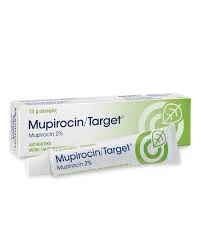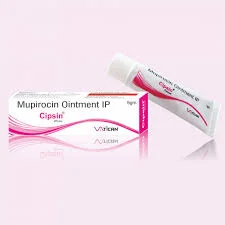Mupirocin, an antibiotic known for its unique characteristics, has been making waves in the medical field. Its effectiveness against certain infections and its distinctive mode of action have garnered attention from healthcare professionals and patients alike. But what exactly sets mupirocin apart from other antibiotics? In this blog post, we will delve into the fascinating world of mupirocin to uncover why it stands out among its counterparts. So sit back, grab a cup of tea (or your beverage of choice), and let's embark on a journey to discover the extraordinary qualities that make mupirocin so special!
What is mupirocin?
Mupirocin, also known by its brand name Bactroban, is a potent antibiotic used to treat bacterial skin infections. It belongs to a class of antibiotics called monoxycarbolic acids and works by inhibiting the synthesis of proteins that are essential for bacteria growth.
One of the key features of mupirocin is its narrow spectrum activity. Unlike some broad-spectrum antibiotics that target a wide range of bacteria, mupirocin specifically targets certain types of bacteria such as Staphylococcus aureus and Streptococcus pyogenes. This targeted approach helps reduce the risk of developing antibiotic resistance and allows for more effective treatment.
Mupirocin is available in different forms including ointments, creams, and nasal sprays. Topical formulations are commonly used to treat skin infections like impetigo or folliculitis, while nasal formulations can help eliminate harmful bacteria residing in the nasal passages.
Another unique characteristic of mupirocin is its low potential for systemic absorption. When applied topically, it tends to stay localized at the site of application without significantly entering the bloodstream. This means fewer systemic side effects compared to oral antibiotics.
In addition to treating various skin infections, mupirocin has shown efficacy in preventing infection in surgical wounds and reducing nasal carriage rates among healthcare workers colonized with MRSA (methicillin-resistant Staphylococcus aureus).
Mupirocin's specific antibacterial properties coupled with minimal systemic absorption make it an invaluable tool in managing bacterial skin infections efficiently and effectively. However, it's important to note that proper usage guidelines should always be followed under medical supervision for optimal results and safety.

How does mupirocin work?
Mupirocin, a powerful antibiotic, works by targeting the bacteria that cause infections. It belongs to a class of antibiotics known as topical antibacterials. When applied to the skin or inside the nose, mupirocin prevents bacteria from growing and spreading.
The unique mechanism of action makes mupirocin an effective treatment for various skin infections caused by certain strains of Staphylococcus aureus and Streptococcus pyogenes. This antibiotic inhibits bacterial protein synthesis by binding to a specific enzyme called isoleucyl tRNA synthetase.
By disrupting this essential process, mupirocin essentially stops bacteria from producing proteins necessary for their survival and multiplication. As a result, it effectively eliminates these harmful microorganisms and helps in clearing up infections.
What sets mupirocin apart from other antibiotics is its narrow spectrum of activity. Unlike many broad-spectrum antibiotics that can also kill beneficial bacteria in our bodies, mupirocin primarily targets only the specific types of bacteria responsible for causing infection. This targeted approach reduces unnecessary disruption to the natural balance of microorganisms on our skin or mucous membranes.
In addition to its unique mode of action, another remarkable characteristic is that resistance to mupirocin is relatively uncommon compared to other antibiotics used topically or systemically. However, like with any antibiotic use, it's crucial not to overuse or misuse mupirocin as this can contribute to the development of resistant strains over time.
Understanding how mupirocin works highlights its significance in treating localized bacterial infections such as impetigo (a highly contagious skin condition) or nasal colonization with methicillin-resistant Staphylococcus aureus (MRSA). By specifically targeting relevant pathogens while preserving normal flora on our body surfaces, it serves as an invaluable tool for healthcare providers combating these types of infections effectively.
To ensure safe usage and maximize effectiveness while minimizing adverse effects or resistance development, it is essential to follow the prescribed dosage and application instructions provided by a healthcare professional.
What makes mupirocin unique?
What makes mupirocin unique? Let's dive into the characteristics that set this antibiotic apart from others.
First and foremost, mupirocin is specifically designed to target and kill certain types of bacteria, such as Staphylococcus aureus and Streptococcus pyogenes. This targeted approach helps minimize the risk of developing bacterial resistance, which can be a major concern with other antibiotics.
Another unique aspect of mupirocin is its mode of action. It works by inhibiting the synthesis of proteins in bacteria, ultimately leading to their death. Unlike some other antibiotics that attack various cellular processes within bacteria, mupirocin's specificity allows for more precise treatment.
Additionally, what sets mupirocin apart is its excellent topical application. It comes in different forms like ointments or creams that are easy to apply directly on the skin where infections occur most frequently - think impetigo or infected wounds. This localized treatment minimizes systemic exposure and reduces potential side effects compared to oral or intravenous antibiotics.
Furthermore, unlike many antibiotics available today, mupirocin has minimal absorption through intact skin. This means it stays primarily at the site of infection without entering your bloodstream extensively—a significant advantage when it comes to reducing potential drug interactions or systemic toxicity risks.
Several factors make mupirocin a unique antibiotic: its ability to target specific bacteria while minimizing resistance development; its mode of action blocking protein synthesis; its effective topical applications; and limited absorption through intact skin resulting in reduced side effects and drug interactions.

Why is mupirocin important?
Mupirocin, an antibiotic with unique characteristics, plays a vital role in the medical field. One important aspect of mupirocin is its ability to effectively treat skin infections caused by certain types of bacteria. These infections can range from minor cuts and scrapes to more severe conditions like impetigo or folliculitis.
Due to its specific mechanism of action, mupirocin targets the bacterial protein synthesis process. It works by inhibiting the activity of an enzyme called isoleucyl-tRNA synthetase, which is necessary for bacterial growth and reproduction. By disrupting this crucial step, mupirocin stops bacteria from multiplying and ultimately helps eliminate the infection.
Another significant benefit of mupirocin is its limited resistance development compared to other antibiotics. This makes it an invaluable tool in combating antibiotic-resistant strains of bacteria that have become increasingly prevalent in recent years.
Moreover, mupirocin's topical formulation allows for targeted application directly onto infected areas, minimizing systemic exposure and potential side effects associated with oral or intravenous antibiotics.
In addition to treating skin infections, mupirocin also has a preventative role in reducing the spread of methicillin-resistant Staphylococcus aureus (MRSA) colonization within healthcare settings such as hospitals or nursing homes. Its use as a nasal ointment can help reduce MRSA transmission among patients and healthcare workers alike.
To ensure safe usage, it is essential to follow prescribed guidelines when applying mupirocin topically. Adhering to proper hygiene practices such as handwashing before and after application can further enhance its efficacy while reducing any risk of cross-contamination.
Understanding the importance of mupirocin highlights how this unique antibiotic contributes significantly to effective treatment options for various skin infections while helping combat antibiotic resistance on both individual and public health levels.

How to use mupirocin safely
Using mupirocin safely is crucial to ensure its effectiveness in treating bacterial infections. Here are some important guidelines to keep in mind:
1. Clean the affected area: Before applying mupirocin, gently clean the affected skin with mild soap and water. Pat it dry with a clean towel or tissue.
2. Apply a thin layer: Take a small amount of mupirocin on your fingertip or a cotton swab and apply it directly onto the affected area. Make sure to cover only the infected region and avoid spreading it unnecessarily.
3. Wash hands before and after use: Practicing good hand hygiene is essential to prevent further contamination or spread of infection. Wash your hands thoroughly before and after applying mupirocin.
4. Follow dosage instructions: Always follow your healthcare provider's instructions regarding the frequency, duration, and amount of mupirocin to be used. Do not exceed the prescribed dosage as this may increase the risk of side effects.
5. Avoid contact with eyes, nose, mouth: Mupirocin is intended for external use only; therefore, avoid getting it into your eyes, nose, or mouth as it may cause irritation or other adverse effects.
6. Finish full course treatment: Even if symptoms improve before completing the prescribed course of treatment, continue using mupirocin until instructed otherwise by your healthcare provider to ensure complete eradication of bacteria.
Remember that these guidelines provide general information for safe usage but always consult with your doctor or pharmacist for specific instructions based on your condition.
Conclusion
Mupirocin is a unique antibiotic that offers several distinct characteristics. Its mechanism of action targets the bacterial protein synthesis process, making it highly effective against a variety of skin infections caused by bacteria such as Staphylococcus aureus and Streptococcus pyogenes.
One of the key features that sets mupirocin apart from other antibiotics is its narrow spectrum of activity. It specifically targets certain strains of bacteria without affecting the natural balance of beneficial microorganisms on the skin. This makes mupirocin an ideal choice for treating localized infections, particularly those in sensitive areas like the nose and around wounds.
In addition to its effectiveness and limited resistance profile, another factor contributing to the uniqueness of mupirocin is its safety profile when used as directed. The topical formulation minimizes systemic absorption, reducing the risk of adverse effects associated with oral antibiotics.
When using mupirocin, it is crucial to follow proper guidelines and instructions provided by healthcare professionals or included with the product packaging. Adhering to recommended dosages and treatment durations will help maximize efficacy while minimizing potential side effects or complications.
Mupirocin stands out among other antibiotics due to its targeted approach in combating specific types of bacteria without disrupting healthy microbial communities on our skin. Its ability to effectively treat localized skin infections while maintaining a low risk for developing resistance makes it invaluable in medical practice. By understanding how this unique antibiotic works and following safe usage practices, we can harness its benefits fully while protecting ourselves from unnecessary risks.
Shanghai Minbiotch Biotechnology Co., Ltd.Minbiotch Co., Ltd. is a company specializing in the RD and production of advanced pharmaceutical intermediates and biological APIs. The company is committed to the research and development of biomedicine. Its main products are monoclonal antibodies, ADC small molecule toxins, anti COVID-19 raw materials, mRNA nucleosides needed by the production of vaccines, and a variety of high-end generic drugs and innovative drugs.Welcome to inquiry if you need to know more about Mupirocin details or order wholesale.Sales@minbiotech.com








